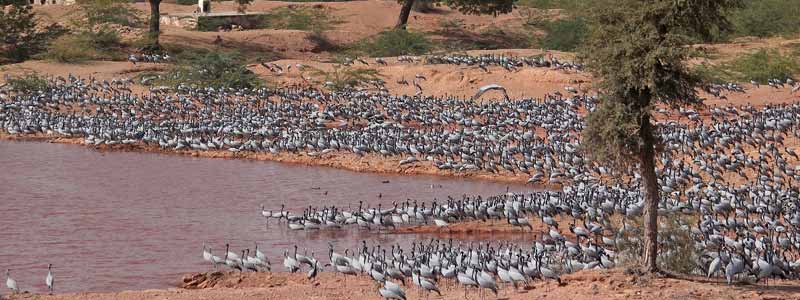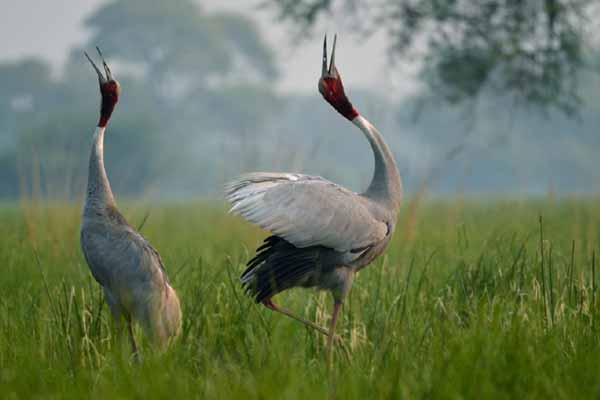Bird Watching in Rajasthan offers a captivating blend of avian diversity against the backdrop of the state’s rich cultural and natural heritage. With its varied landscapes including deserts, wetlands, forests, and arid grasslands, Rajasthan provides a unique habitat for a wide range of bird species.
The Keoladeo National Park, also known as Bharatpur Bird Sanctuary, is a UNESCO World Heritage site and a haven for bird enthusiasts. Located in Bharatpur, it is home to over 370 species of birds, including migratory species like the Siberian Crane, and is a crucial breeding ground for many others. The sanctuary’s marshy terrain and shallow lakes attract a profusion of waders, waterfowl, and raptors.
Ranthambhore National Park, renowned for its tigers, is also a treasure trove for bird watchers. The park’s diverse topography, which includes grasslands, lakes, and dense forests, hosts an array of birdlife. One can spot raptors like the Crested Serpent Eagle and the White-eyed Buzzard, as well as colorful species like the Indian Pitta and the Paradise Flycatcher.
In the desert region, the Tal Chhapar Sanctuary is a must-visit for bird lovers. Located in the Churu district, it is a unique grassland ecosystem and a habitat for the critically endangered Lesser Florican. This sanctuary is also home to various larks, sandgrouse, and raptors.
The desert landscapes of Jaisalmer and Jodhpur are frequented by birds adapted to arid conditions. The Godawari and Jawai dams near Udaipur provide important wetland habitats attracting numerous waterfowl species, making them excellent birding spots.
Apart from these prominent locations, Rajasthan’s countryside is dotted with small ponds, lakes, and agricultural fields, which serve as crucial stopovers for migratory birds. This makes the entire state a rewarding destination for bird watchers throughout the year Wildlife in Rajasthan.
With its rich avifauna and diverse landscapes, bird watching in Rajasthan offers a unique and enriching experience for both avid birders and casual enthusiasts, combining the thrill of bird sightings with the cultural charm of this historic region.

Khichan Bird Sanctuary
The Khichan Bird Sanctuary, located in the heart of the Thar Desert in Rajasthan, India, is a haven for migratory birds, particularly the Demoiselle Cranes (Grus virgo). Covering an area of approximately 6.83 hectares, this sanctuary is a crucial stopover point for these elegant birds during their long migration journey.
The sanctuary’s main attraction, the Demoiselle Cranes, arrive in Khichan between the months of August and March, seeking refuge from the harsh winter conditions of their breeding grounds in Central Asia. It is estimated that thousands of these cranes visit the sanctuary annually, creating a mesmerizing spectacle for bird enthusiasts Rajasthan Wildlife Tour Package.
The villagers of Khichan play a significant role in the conservation efforts of the sanctuary. They have been providing food to the cranes for decades, which has created a strong bond between the local community and the birds. Feeding stations have been set up, where the birds are offered grains and water, ensuring their sustenance during their stay.
Apart from Demoiselle Cranes, the sanctuary also hosts a variety of other bird species, including raptors like eagles and vultures, as well as various waterfowl and passerines. This makes Khichan a diverse birdwatching destination, offering opportunities for bird enthusiasts to observe a wide range of avian species in their natural habitat.
The Khichan Bird Sanctuary stands as a remarkable example of how local communities can play a crucial role in bird conservation. The efforts of the villagers have turned this small hamlet into a globally recognized birding destination, drawing visitors from all over the world to witness the awe-inspiring sight of thousands of Demoiselle Cranes in flight.
Ranthambore National Park
Ranthambore National Park, located in the Sawai Madhopur district of Rajasthan, India, is one of the country’s most renowned wildlife reserves. Spread over an area of approximately 392 square kilometers, it is known for its rich biodiversity and, in particular, its population of Bengal tigers.
The park is characterized by a diverse range of habitats, including dry deciduous forests, open grasslands, and several lakes and rivers. This varied terrain provides a conducive environment for a wide array of wildlife species. Aside from tigers, Ranthambore is home to leopards, sloth bears, wild boars, sambar deer, and various species of birds.
Ranthambore’s star attraction, the Bengal tiger, is a dominant presence in the park. Visitors have the opportunity to witness these magnificent creatures in their natural habitat, making it one of the best places in India for tiger sightings. The park’s unique topography, which includes ancient ruins and historic structures, adds an extra layer of intrigue to the safari experience.
The park’s flora is equally diverse, with a variety of trees, shrubs, and grasses providing essential habitats for its wildlife. The park is also home to numerous bird species, making it a haven for bird enthusiasts. Species like the crested serpent eagle, Indian pitta, and paradise flycatcher can be spotted in the park.
Ranthambore National Park offers a range of safari options, including jeep safaris and canter safaris, providing visitors with the opportunity to explore the park’s wilderness and encounter its fascinating inhabitants. The best time to visit is from October to June, with the winter months being particularly popular for wildlife enthusiasts.
Overall, Ranthambore National Park stands as a testament to the harmonious coexistence of wildlife and history, making it a must-visit destination for nature lovers and wildlife enthusiasts alike.
Keoladeo National Park
Keoladeo National Park, also known as Bharatpur Bird Sanctuary, is a jewel in the crown of Rajasthan’s wildlife sanctuaries. Located in the town of Bharatpur, it spans an area of approximately 29 square kilometers and is renowned for its astounding avian diversity. Designated as a UNESCO World Heritage site, this park is a sanctuary for both resident and migratory bird species.
One of the most striking features of Keoladeo National Park is its rich wetland habitat. The park is characterized by marshes, shallow lakes, reed beds, and grasslands, creating an ideal environment for a myriad of bird species. Over 370 species of birds have been documented here, making it a birdwatcher’s paradise.
During the winter months, Keoladeo becomes a bustling haven for migratory birds, with species arriving from as far as Siberia and Central Asia. The arrival of the elegant Siberian Cranes is a highlight, as they seek refuge in the park’s tranquil waters.
Apart from the Siberian Crane, visitors can spot a wide range of waterfowl, waders, raptors, and passerines. Species like painted storks, herons, ibises, ducks, and geese are commonly seen, along with birds of prey like eagles, vultures, and owls.
The park’s network of well-maintained trails and observation points provides excellent opportunities for birdwatching and photography. Nature enthusiasts can explore the park on foot, bicycle, or via cycle rickshaws, guided by knowledgeable naturalists who offer valuable insights into the park’s avian inhabitants Bird Watching in Rajasthan.
With its incredible birdlife set against a backdrop of lush vegetation and serene water bodies, Keoladeo National Park stands as a testament to the importance of preserving critical habitats for the conservation of avian biodiversity. It is a must-visit destination for bird lovers and wildlife enthusiasts from around the world.
Desert National Park
The Desert National Park, situated in the western state of Rajasthan, India, is a captivating testament to the stark beauty and biodiversity that can be found in arid landscapes. Covering an extensive area of over 3,162 square kilometers, it stands as one of the largest national parks in the country.
The park is renowned for its unique and varied ecosystem, characterized by shifting sand dunes, rocky outcrops, and sparse vegetation. This harsh environment is nonetheless home to a surprisingly diverse range of wildlife, specially adapted to survive in the desert. Notable species include the elusive desert fox, the Indian gazelle (chinkara), and the nimble-footed blackbuck. The park also provides refuge for reptiles such as the spiny-tailed lizard and the venomous saw-scaled viper.
One of the park’s most significant attractions is the critically endangered Great Indian Bustard, an impressive ground-dwelling bird native to the region. The park’s conservation efforts are particularly focused on safeguarding this majestic species and its fragile habitat.
The Desert National Park is not only a haven for wildlife enthusiasts but also offers a wealth of archaeological and historical treasures. The remnants of ancient trade routes, including temples, reservoirs, and forts, provide a fascinating glimpse into the region’s rich cultural heritage.
Visitors to the park can embark on guided safaris and nature walks, allowing them to immerse themselves in the unique desert environment and witness its inhabitants in their natural habitat. The best time to visit is during the winter months, when the weather is milder and migratory birds join the local residents, adding further diversity to the avian population.
Overall, the Desert National Park is a testament to the resilience and adaptability of life in the harshest of environments, offering a one-of-a-kind experience for those seeking to explore the wonders of Rajasthan’s desert wilderness Bird Watching in Rajasthan.
Kumbhalgarh Wildlife Sanctuary
Kumbhalgarh Wildlife Sanctuary, situated in the rugged terrain of the Aravalli Range in Rajasthan, India, is a sanctuary that spans over 600 square kilometers. It is named after the historic Kumbhalgarh Fort that stands tall within its boundaries. Established in 1971, this sanctuary is a vital part of the larger conservation efforts in the region.
The sanctuary is renowned for its rich biodiversity and serves as a haven for various wildlife species. It is home to a diverse range of fauna, including mammals like leopards, sloth bears, wild boars, and antelopes. The sanctuary also shelters several species of reptiles and a variety of bird species, making it a paradise for birdwatchers.
One of the most significant features of Kumbhalgarh Wildlife Sanctuary is its healthy population of wolves, which is relatively rare in India. These elusive creatures find refuge in the sanctuary’s rugged terrain, away from human disturbances.
The sanctuary’s terrain is characterized by steep slopes, plateaus, and valleys, covered with dense forests of teak, sal, bamboo, and other native vegetation. This creates a varied habitat that supports the diverse wildlife found here.
Visitors to Kumbhalgarh Wildlife Sanctuary have the opportunity to explore the natural beauty of the Aravalli hills, experience wildlife sightings, and witness the historical grandeur of the Kumbhalgarh Fort, a UNESCO World Heritage site. The sanctuary also offers trekking and safari experiences for those seeking a closer encounter with nature.
Preserving this sanctuary is crucial not only for the conservation of its unique flora and fauna but also for the ecological balance of the entire region. Kumbhalgarh Wildlife Sanctuary stands as a testament to the harmonious coexistence of history and nature, providing a valuable resource for future generations to appreciate and protect Bird Watching in Rajasthan.
